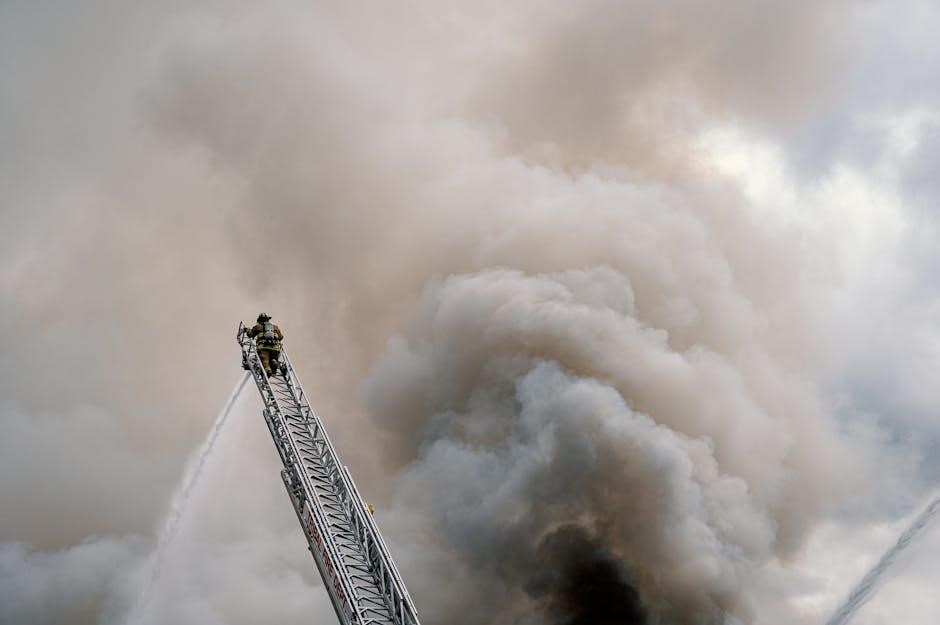Fire extinguishers are essential tools designed to control and extinguish fires, available in various types to suit different fire classes and situations, ensuring effective fire safety.
Overview of Fire Extinguisher Types and Their Importance
Fire extinguishers are categorized into several types, each designed to combat specific classes of fires. The primary types include water, foam, dry chemical, carbon dioxide, and wet chemical extinguishers. Each type targets distinct fire hazards, such as combustible materials, flammable liquids, electrical fires, or cooking oils. Their importance lies in their ability to suppress fires effectively, preventing escalation and reducing risks to people and property. Proper selection and use of fire extinguishers are critical, as using the wrong type can exacerbate a fire. Understanding their classifications ensures effective fire safety and response in various environments, from homes to laboratories and industrial settings.

Classes of Fires
Fires are classified into types A, B, C, D, and K based on the fuel source. Proper classification ensures the correct extinguisher is used for safety and effectiveness.
Class A Fires: Combustible Materials

Class A fires involve ordinary combustible materials such as wood, paper, cloth, rubber, and plastics. These fires are typically fueled by solid materials and can spread quickly if not controlled. Water-based extinguishers are most effective for Class A fires as they cool the fuel source, reducing the temperature below the ignition point. It is crucial to use the correct extinguisher type to avoid re-ignition or spreading the fire. Proper training and equipment are essential for safely managing Class A fires, which are common in both residential and commercial settings. Understanding their characteristics ensures effective fire suppression and prevents potential hazards. Regular inspection of fire extinguishers is vital for readiness in emergencies.

Class B Fires: Flammable Liquids
Class B fires involve flammable liquids such as gasoline, oil, paint, and propane. These fires can spread rapidly and are often challenging to control due to the liquid’s ability to flow and reignite. Foam extinguishers are highly effective for Class B fires as they smother the flames and prevent re-ignition by sealing the surface. Dry chemical extinguishers are also suitable for Class B fires, as they disrupt the chemical reaction necessary for combustion. It is critical to avoid using water-based extinguishers on Class B fires, as water can cause the liquid to spread, worsening the situation. Proper training and equipment are essential to safely manage Class B fires, which frequently occur in industrial and automotive settings. Regular maintenance of extinguishers ensures they are ready for emergencies.

Class C Fires: Electrical Fires
Class C fires involve electrical equipment, such as appliances, wiring, or circuit breakers, where the fuel source is electricity. These fires require specialized extinguishing agents to prevent further damage and ensure safety. Carbon dioxide (CO2) extinguishers are ideal for Class C fires, as they smother the flames without leaving a residue that could damage sensitive electrical components. Dry chemical extinguishers, particularly those rated for Class C fires, can also be effective. However, water-based extinguishers should never be used on Class C fires, as they conduct electricity and can cause severe injury or worsen the situation. Proper training and the use of non-conductive extinguishing agents are crucial for safely managing Class C fires, which often occur in industrial or office settings with electrical infrastructure. Regular inspection of fire extinguishers ensures readiness for such emergencies.
Class D Fires: Combustible Metals
Class D fires involve combustible metals such as magnesium, titanium, or sodium, which burn at extremely high temperatures. These fires are unique because water and standard extinguishing agents can react with the metals, worsening the situation. Specialized extinguishing agents, such as dry powder formulations, are required to smother the fire and prevent oxygen from fueling it. These powders are designed to cover the metal surface, starving the fire of oxygen and cooling it below its ignition temperature. Class D fires often occur in industrial settings, such as metal fabrication or storage areas, and require specific training to handle safely. Proper equipment, like fire extinguishers rated for Class D fires, is essential to manage these dangerous situations effectively.
Class K Fires: Cooking Oils and Fats

Class K fires involve cooking oils and fats, commonly occurring in commercial kitchens. These fires are particularly dangerous due to the high heat and splashing that can occur when extinguishing agents are applied. Wet chemical extinguishers are specifically designed for Class K fires, as they create a cooling effect and form a protective barrier on the surface of the oil or fat, preventing reignition. Water and foam extinguishers are ineffective and can worsen the situation by causing the oil to splash and spread the fire. Proper training and the use of Class K-rated extinguishers are crucial to safely manage these types of fires in high-risk environments like restaurants and food processing facilities, ensuring both safety and compliance with fire safety regulations.
Types of Fire Extinguishers
Fire extinguishers vary by type, including water, foam, dry chemical, carbon dioxide, and wet chemical, each designed for specific fire classes to ensure effective fire suppression.
Water-Based Extinguishers: Effective Against Class A Fires
Water-based extinguishers are specifically designed to combat Class A fires, which involve combustible materials like wood, paper, cloth, and plastics. They work by cooling the fuel source, reducing the temperature below the ignition point, and smothering the fire. These extinguishers are highly effective for ordinary combustible materials but are not suitable for Class B, C, or K fires. Using water on electrical or grease fires can worsen the situation, making them unsafe choices in such scenarios. Water-based extinguishers are ideal for general use in homes, offices, and public spaces where Class A fires are most common. Always ensure the extinguisher is rated for the specific fire type to avoid dangerous outcomes.

Foam Extinguishers: Suitable for Class A and B Fires
Foam extinguishers are versatile, designed to tackle both Class A and Class B fires. Class A fires involve combustible solids like wood and paper, while Class B fires involve flammable liquids such as gasoline, oil, and paint. Foam works by smothering the fire, starving it of oxygen, and cooling the surface. It is particularly effective on liquid fires as it prevents reignition by forming a barrier. However, foam extinguishers are not suitable for Class C electrical fires or Class K cooking oil fires. They are commonly used in industrial settings, garages, and areas where flammable liquids are present. Always check the extinguisher’s rating to ensure it matches the fire type for safe and effective use. Regular maintenance is crucial to maintain their functionality.
Dry Chemical Extinguishers: Multipurpose for Class A, B, and C Fires
Dry chemical extinguishers are widely used due to their versatility in combating Class A, B, and C fires. Class A involves solids like wood and paper, Class B includes flammable liquids, and Class C pertains to electrical fires. These extinguishers work by releasing a dry chemical agent that smothers the fire, interrupting the chemical reaction, and cooling the area. They are effective in various settings, including homes, offices, and industrial spaces. However, they leave a residue, which may require cleanup. It’s important to choose the correct size and type for the specific fire hazard. Regular inspections ensure they are ready for use. Always follow safety guidelines when operating these extinguishers. They are a reliable choice for multi-risk environments. Proper training is essential for effective use. Maintenance is key to their functionality.
Carbon Dioxide Extinguishers: Ideal for Electrical Fires
Carbon dioxide (CO2) extinguishers are specialized for combating electrical fires, making them a crucial tool in protecting sensitive equipment. They work by displacing oxygen, smothering the fire without causing damage to electrical components; CO2 extinguishers leave no residue, ideal for use in areas with computers, servers, and other electronic devices. They are effective on Class C fires, involving energized electrical equipment. However, they are not suitable for Class A or B fires. Proper training is essential to ensure safe and effective use. Regular maintenance and inspections are necessary to maintain their functionality. Always follow safety guidelines when operating CO2 extinguishers, as they can displace oxygen in enclosed spaces. They are a reliable choice for protecting valuable electrical assets.
Wet Chemical Extinguishers: Designed for Class K Fires
Wet chemical extinguishers are specifically engineered to combat Class K fires, which involve cooking oils and fats. These extinguishers are essential in commercial kitchens, restaurants, and food processing areas. They work by cooling the fuel and forming a soapy foam barrier that prevents reignition. Wet chemical extinguishers are highly effective for deep fat fryers and cooking appliances. They are not suitable for other fire classes like A, B, or C. Proper installation and training are crucial to ensure safe and effective use. Regular inspections and maintenance are necessary to maintain their reliability. They provide a vital defense against high-risk cooking fires, safeguarding both people and property. Their specialized design makes them indispensable in environments where cooking oils are present. Always use them according to safety guidelines to maximize their effectiveness.

Safe Use and Handling of Fire Extinguishers
Proper use and handling of fire extinguishers are critical for effective fire safety. Always ensure the extinguisher is rated for the specific fire class. Before using, inspect the extinguisher for damage or low pressure. The PASS method is essential: Pull the safety pin, Aim the nozzle at the base of the fire, Squeeze the handle, and Sweep the nozzle from side to side. Never fight large or spreading fires; prioritize evacuation. Use extinguishers only on small, contained fires. Familiarize yourself with the extinguisher’s operation beforehand. Proper training and awareness are key to safe and effective use. Always prioritize personal safety and follow guidelines strictly to avoid accidents and ensure successful fire control. Regular drills and practice can enhance readiness and confidence in emergency situations. Stay calm and act decisively when using a fire extinguisher to minimize risks and protect lives. Proper handling ensures the extinguisher functions as intended, maximizing its effectiveness in emergencies. Always maintain a safe distance and be aware of your surroundings while operating the extinguisher. If unsure, evacuate the area and await professional assistance. Fire extinguishers are lifesaving tools when used correctly and responsibly. Remember, safety should always come first in any fire situation. Effective use requires knowledge, preparation, and adherence to established protocols. Always follow manufacturer guidelines and local fire safety regulations to ensure optimal performance and safety. Fire extinguishers are a vital component of fire safety, but they must be used appropriately to be effective. Misuse can lead to further danger, so understanding their proper application is crucial. Stay informed and prepared to handle fire emergencies confidently and safely. Fire extinguishers are a reliable defense against small fires, but they require careful handling and awareness of their limitations. Always assess the situation before engaging, and never hesitate to seek help if the fire is beyond control. Proper training and awareness are key to safe and effective use. Always prioritize personal safety and follow guidelines strictly to avoid accidents and ensure successful fire control. Regular drills and practice can enhance readiness and confidence in emergency situations. Stay calm and act decisively when using a fire extinguisher to minimize risks and protect lives. Proper handling ensures the extinguisher functions as intended, maximizing its effectiveness in emergencies. Always maintain a safe distance and be aware of your surroundings while operating the extinguisher. If unsure, evacuate the area and await professional assistance. Fire extinguishers are lifesaving tools when used correctly and responsibly. Remember, safety should always come first in any fire situation. Effective use requires knowledge, preparation, and adherence to established protocols. Always follow manufacturer guidelines and local fire safety regulations to ensure optimal performance and safety. Fire extinguishers are a vital component of fire safety, but they must be used appropriately to be effective. Misuse can lead to further danger, so understanding their proper application is crucial. Stay informed and prepared to handle fire emergencies confidently and safely. Fire extinguishers are a reliable defense against small fires, but they require careful handling and awareness of their limitations. Always assess the situation before engaging, and never hesitate to seek help if the fire is beyond control. Proper training and awareness are key to safe and effective use. Always prioritize personal safety and follow guidelines strictly to avoid accidents and ensure successful fire control. Regular drills and practice can enhance readiness and confidence in emergency situations. Stay calm and act decisively when using a fire extinguisher to minimize risks and protect lives. Proper handling ensures the extinguisher functions as intended, maximizing its effectiveness in emergencies. Always maintain a safe distance and be aware of your surroundings while operating the extinguisher. If unsure, evacuate the area and await professional assistance. Fire extinguishers are lifesaving tools when used correctly and responsibly. Remember, safety should always come first in any fire situation. Effective use requires knowledge, preparation, and adherence to established protocols. Always follow manufacturer guidelines and local fire safety regulations to ensure optimal performance and safety. Fire extinguishers are a vital component of fire safety, but they must be used appropriately to be effective. Misuse can lead to further danger, so understanding their proper application is crucial. Stay informed and prepared to handle fire emergencies confidently and safely. Fire extinguishers are a reliable defense against small fires, but they require careful handling and awareness of their limitations. Always assess the situation before engaging, and never hesitate to seek help if the fire is beyond control. Proper training and awareness are key to safe and effective use. Always prioritize personal safety and follow guidelines strictly to avoid accidents and ensure successful fire control. Regular drills and practice can enhance readiness and confidence in emergency situations. Stay calm and act decisely when using a fire extinguisher to minimize risks and protect lives. Proper handling ensures the extinguisher functions as intended, maximizing its effectiveness in emergencies. Always maintain a safe distance and be aware of your surroundings while operating the extinguisher. If unsure, evacuate the area and await professional assistance. Fire extinguishers are lifesaving tools when used correctly and responsibly. Remember, safety should always come first in any fire situation. Effective use requires knowledge, preparation, and adherence to established protocols. Always follow manufacturer guidelines and local fire safety regulations to ensure optimal performance and safety. Fire extinguishers are a vital component of fire safety, but they must be used appropriately to be effective. Misuse can lead to further danger, so understanding their proper application is crucial. Stay informed and prepared to handle fire emergencies confidently and safely. Fire extinguishers are a reliable defense against small fires, but they require careful handling and awareness of their limitations. Always assess the situation before engaging, and never hesitate to seek help if the fire is beyond control.
Effective Fire Safety with the Right Extinguisher
Maintenance and Inspection Requirements
Regular maintenance and inspections of fire extinguishers are crucial to ensure their reliability in emergencies. Inspect extinguishers monthly, checking for damage, proper pressure levels, and accessibility. Annual professional inspections are mandatory to comply with safety standards. Ensure all components, such as nozzles and hoses, are in good condition. Recharge extinguishers immediately after use or if pressure drops below safe levels. Follow manufacturer guidelines for servicing and replacement. Proper maintenance prevents malfunction and ensures readiness. Neglecting inspections can lead to equipment failure, posing serious risks. Always keep extinguishers visible, accessible, and free from obstructions. Record inspection dates on the extinguisher’s tag for compliance. Regular upkeep is vital to safeguard lives and property effectively.